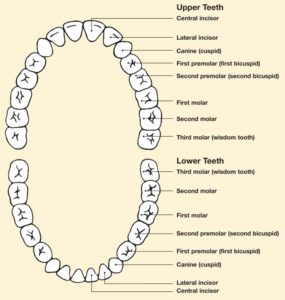
I remember a time when, by your senior year in high school, it was assumed that teens would have their wisdom teeth removed. Now as a dentist, we believe that evaluation of wisdom teeth removal should be made on a case by case basis. In our Shelby Township dental office, removing these teeth is not made “rule of thumb.”
However, removal is (and has been) based on the history of wisdom teeth, which tend to cause problems as these large teeth erupt. Their size increases the potential to crowd other teeth, which can lead to bite misalignment. This can detract from a smile’s appearance as well as pose problems in the future.
As a neuromuscular dentist, I see patients almost daily who have endured years of headaches, migraines, ear ringing and dizziness – all a result of a bite that was “off.” Bite misalignment can lead to disorders associated with the jaw joints, commonly known as TMJ. Helping your child achieve a properly balanced bite can save them from years of discomfort from this seemingly unrelated source.
Another reason to remove wisdom teeth is the difficulty in keeping them clean. The deep grooves in the tops of these teeth and their far-back positions make them hard to reach, so brushing and flossing can be less thorough. This is not only a recipe for cavities, gum disease can eventually develop.
Periodontal (gum) disease, is an inflammatory disease that attacks gum tissues. Beneath the gumline, these infectious bacteria can destroy the structures that support teeth, including bone. Gum disease symptoms including persistent bad breath, tender gums that bleed when brushing, and gums that turn red. Keeping these hard-to-reach teeth clean and healthy may be difficult, but very necessary.
Yet, another reason for removal – wisdom teeth are subject to impaction. When a wisdom tooth is “impacted,” it is because the tooth is buried (either partially or completely) in the soft tissue or jaw bone. This leaves them more susceptible to disease and other problems, including cysts or tumors. If a tooth is fully impacted in bone and X-rays show that eruption is unlikely, or there is pain in the upper or lower jaw, we typically advise removal.
Indications of an impacted molar may be a sensation of pressure in the back of the mouth. Also, the gum tissue around the erupting wisdom tooth becomes sensitive, swollen and inflamed. However, some people have no symptoms although problems may exist below the gumline. This is where our advanced imaging technology is ideal.
Cone Beam 3D imaging provides clear, concise views at the lowest radiation levels possible. It is used to reveal what standard panorex or bite wings don’t, such as lower wisdom teeth in proximity to the mandibular (lower jaw) nerve canal. It is also used for evaluation of teeth and bone for signs of infections, cysts, or tumors even in early formation stages. Knowing these intricate details help us provide the most conservative treatment possible.
If wisdom tooth removal is deemed necessary or beneficial to the patient’s current or future oral health, rest assured that we provide comfort options that include oral or I.V. sedation (“twilight sleep”). These are administered by trained professionals and the patient is closely monitored by trained team members who utilize advanced safety equipment. We are known for our emphasis on comfort, but patient safety is always our top priority.
Recovery from being sedated is fairly quick. If IV sedation is administered, the patient is typically back to normal within 24 hours. As the areas of removal heal, mild to moderate pain is normal. We recommend medications to minimize discomfort and instructions on how to remain comfortable, especially in the first few days. Complications are few and rare, but possible. These may include:
• Pain – In addition to non-steroidal anti-inflammatories, icing is recommended for the first 24 hours to minimize swelling.
• Dry socket – Although rare, this typically occurs 4 – 7 days after an extraction when the blood clot needed for healing dissolves too soon. This can be treated with an oral antiseptic or a specialized dressing depending on the severity of pain.
• Subperiosteal abscess – This is a pus pocket that develops when bone and tissue debris are trapped between the healing extraction socket and tissues covering the bone. This is treated by draining the abscess and antibiotics to treat the infection.
Our Macomb County dental office provides complete care for all ages – children, teens and adults. We care for the smiles of many who first came as toddlers and now bring children of their own for dental care. We are often told that the confidence of having one dental team in one location to care for a lifetime of smiles provides peace of mind. This is a great compliment to us!
We are always happy to welcome new patients. If you would like to get to know us through a free consultation appointment, call 586-739-2155 or tap here to begin. You can also visit our Office Tour video for a “walk through” of our environment of skilled care and advanced technology. Of course, we’d love to have you become familiar with all aspects of our comprehensive dental office. Start with our Home page at: WhereLastingSmilesBegin